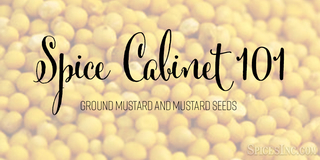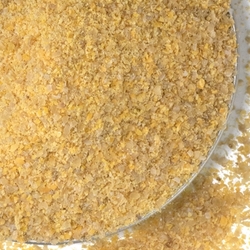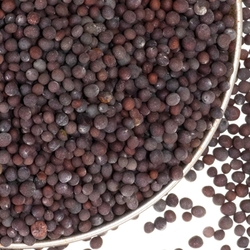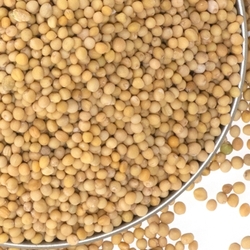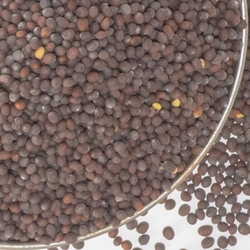Spice Cabinet 101: Mustard
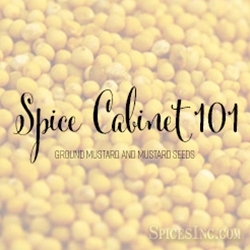
Somewhere in the fierce summer heat, a child is experiencing mustard for the first time. Perhaps it is on a messy hotdog at a barbecue or on a fingertip, curiously scooped up by said child to put in their mouth. This child either loves or hates the mustard.
Mustard is no longer just the neon yellow condiment you find at barbecues, it is a food item that has countless varieties with callbacks to the original mustards of times long ago. Look around at your local grocery store and you are likely to find at least ten different varieties of mustard.
Types of Mustard Seeds
There are over forty types of mustard seeds, but there are three different types of culinary mustard seeds, brown, black, and white, which are sometimes called yellow mustard seeds. Mustard seeds are indigenous to varying areas of Asia and Europe. Brown mustard seeds are native to the foothills of the Himalayan Mountains, black mustard seeds are native to the Middle East and the white or yellow mustard seeds are native to the eastern Mediterranean region. There is reference to mustard seeds even in Sanskrit writings, and their history as a food extends back thousands of years.
White or Yellow Mustard Seeds are the most popular of all the mustard seeds. They are the kind you would expect to find in prepared neon yellow mustards in the grocery store. They are slightly larger in size than other varieties and have no noticeable aroma until they are roasted.
Brown Mustard Seed begins bitter and then becomes more aromatic as it ages. These seeds are more pungent that yellow mustard seeds and also slightly hotter. These are the mustard seeds of choice in African and Indian cuisine and are used in Germany and Russia to make mustard based condiments. They are often used as a substitute for the hard to find black mustard seeds.
Black Mustard Seeds belong to the same family as horseradish and wasabi, so they have a similar kick to them. They are the most difficult mustard seeds to find because they cannot be harvested by the same machines that harvest other types of mustard seeds. They must be handpicked, making production more expensive. These seeds are popular in Indian cooking, particularly fried in oil to make them sweeter and slightly nuttier. This is usually done in an Indian wok called a kadai.
Is Hot Chinese Mustard made from Mustard Seeds?
Hot Chinese Mustard is made from brown mustard seeds. The seeds must be dried and then ground down into a fine powder. This powder has a mercurial oil that produces a sharp bite and aroma that is described as like horseradish. It quickly effects the sinuses when inhaled. This powder is mixed with water and that causes a chemical reaction in the mustard seed powder, leaving behind an unmistakable spiciness. This mustard is popular as a condiment in Chinese cuisine.
What's the Difference Between Ground Mustard and Mustard Powder?
This is one of the most frequently asked questions in terms of ground mustard. Ground mustard is just ground up mustard seeds. This can be accomplished with a food processor or coffee grinder. All of the ground mustards we carry are of this style of grind. A mustard powder is much more finely ground than your ground mustard would be. Our Hot Chinese Mustard is this style of fine grind, so it is considered a mustard powder.
Ground Mustard
Ground mustard is a versatile ingredient that is largely underrated. The flavor of ground mustard compliments many different foods spanning from grilled beef to cabbage. You will find it tastes excellent with roasted beef, cheeses, chicken, curries, dals, fish, cold meats, rabbit, seafood, and sausages. It is also excellent in sauces- hollandaise in particular- mayonnaise, dressings, and dry rubs.
In way of spices, it plays nicely with bay leaves, chili powders, coriander, cumin, dill, fennel, fenugreek, garlic, honey, nigella, parsley, pepper, tarragon, and turmeric. The tradition of making prepared mustard has always included a ground mustard and water, sometimes with those being the only ingredients.
Making Your Own Mustard
As mentioned previously, ground mustard is often used in making homemade mustard. Making it at home allows you to control the intensity of the mustard but also helps keep fresher ingredients in your home. Luckily, mustard preparation is quite easy and any sort of personalization can be done quickly without much effort. Things that are important to consider when making your mustard include:
- Temperature. The temperature of the liquid used in your mustard making will affect the flavor of your final product. Consider the intensity of the heat you are hoping for before you start to mix your mustard. If you want a very hot mustard, use a cold liquid. If you are looking for a milder flavor, a hot liquid would be best suited. Be patient, mustard making is a process and you may need to wait a few days before your mustard is the desired flavor.
- What kind of mustard you want to make. Decide what kind of ground mustard is right for your mustard recipe and then go from there. Hot Chinese mustard will make a spicy mustard, whereas a regular Ground Yellow Mustard will produce something a little bit more mellow.
- Refrigeration. Putting your mustard in the fridge will almost completely halt the mellowing process of your mustard. Only move it to the fridge when your mustard has reached your desired flavor.
Mustard is an amazing spice and condiment for many different occasions. Who knew that there were so many things to do with these little seeds? It almost seems weird to think that Americans associate mustard with that yellow grocery store bottle and not with the other delicious things mustard seed can do. Maybe try your hand at making German Style Mustard tonight!
Read More
Indian Spices and Seasonings
What Spices Go with What Meat?
Most Popular Spices by Cuisine

